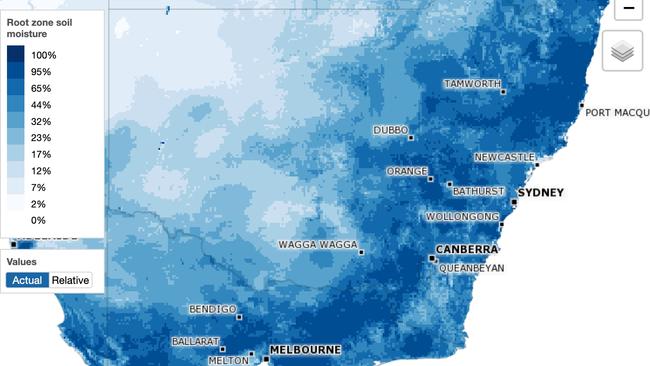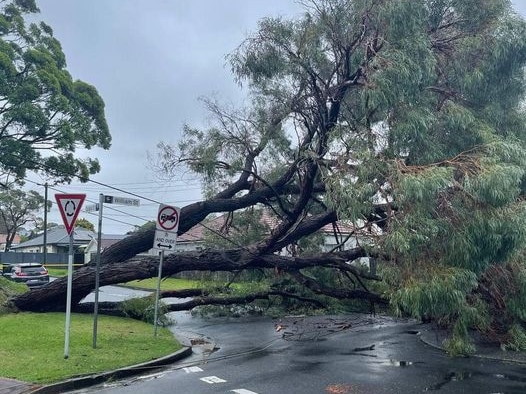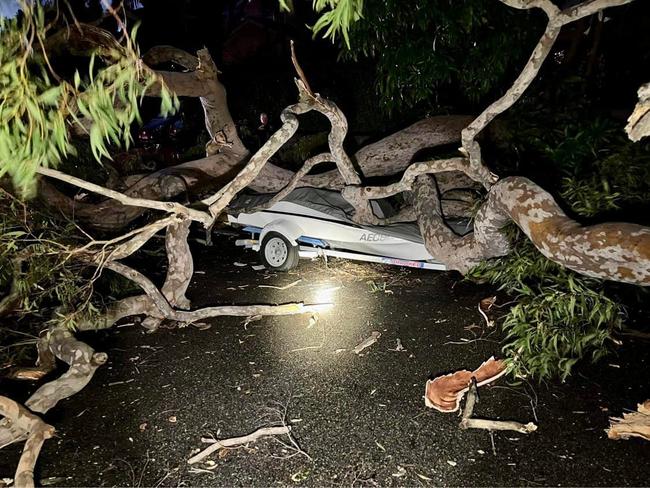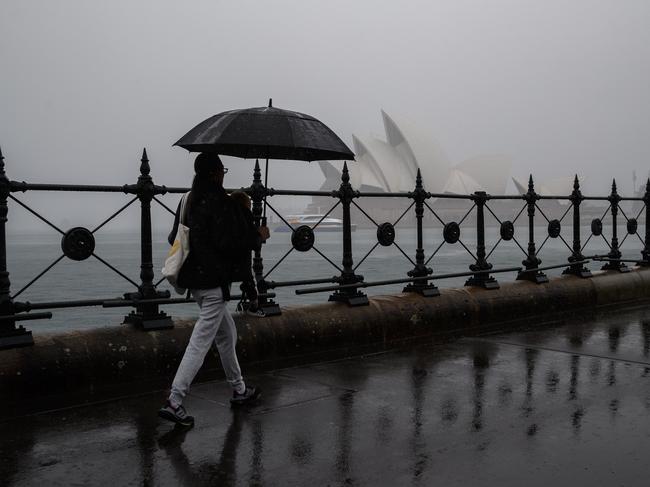Soggy soil menace: How what’s under our feet is making the big wet worse
A very rare third consecutive La Nina has left much of NSW’s soil so sodden it adds to not only flood threats but the very real dangers of fallen trees and landslides.
NSW
Don't miss out on the headlines from NSW. Followed categories will be added to My News.
Sodden Sydneysiders and bedraggled denizens of much of NSW look up to grey skies and sigh as more rain comes. More floods, more mould, more fun is cancelled.
But it’s what’s below their feet which is also now causing concern. Two years of La Ninas creating heavy rain, and now a very rare third consecutive La Nina, have left much of NSW’s soil so sodden it adds to not only flood threats but the very real dangers of fallen trees and landslides.
Soil across vast areas of eastern and central NSW is already close to 100 per cent saturated, according to The Bureau of Meteorology’s (BOM) landscape water balance map.
The third La Nina’s threat of more downpours over the next several months means many places could hit 100 per cent saturation.
The coastal area of Sydney is sitting at about 85 per cent saturated, as is Wollongong and its surrounding regions.

The flood battered Northern Rivers region, thankfully, is sitting around 75 per cent, depending on where you are.
BOM forecaster Jordan Notara said soaked soil makes severe flooding more likely.

“What you will see is the number of run-off incidents in river systems increase,” he said.
“If the soil can’t hold water in the river because it is saturated, then there is more run off.
“Other hazards when you have mountainous regions the likelihood of landslides is higher and there is less wind needed to bring trees down.”
This is because the roots of trees, even big mature trees, can’t get a purchase in the ground.
The State Emergency Services’ (SES) Scott McLennan said that the level of saturation in the soil meant when towns are flooded they are isolated for longer due to the waters not receding as quickly.
“When the ground is more saturated it’s now taking longer to disappear,” Mr McLennan said.

“We have already had some properties isolated for a month now. We have 11 river systems (in NSW) flooded in the western zone and the rain coming will only add to that.”
The SES is preparing for more trees being blown down in any strong wind.
“Because the soil is so moist any bit of wind and these trees get tired and have lie down,” Mr McLennan said.
“That makes the chance of falling trees, landslides and flash flooding very high. It’s a third La Nina year in a row, and they always say the third child is the problem child or the naughty child.”

Sunday’s wet weather will only be the start of a drenching next week as the Bureau of Meteorology warned more flash flooding is on the way.
On top of the rain that is expected in Sydney for the NRL grand final showdown, the BOM has warned inland NSW to brace for severe flash flooding from next Tuesday as a severe weather system blows through.
A clear night is expected in #Sydney for the Grand Final. A little on the chilly side with the temp at Homebush around 15 at the start of the game, dropping to around 13 later. The wind should be less than 10 km/h. Perfect conditions for P..... to win.https://t.co/ulUM7wxI9Rpic.twitter.com/zuoipmFf8q
— Bureau of Meteorology, New South Wales (@BOM_NSW) October 2, 2022
The State Emergency Services is also warning that the 100mm expected over the 48 hours next week is likely to see several road closures.
Those in the Upper Western, Lower Western, North West Slopes and Plains, Central West Slopes and Plains and Central Tablelands regions to be on alert.
“Most major dams at or near capacity,” SES Chief Superintendent David Monk said.
“Any further rainfall is likely to lead to flash flooding developing very quickly resulting in road closures without warning.”
The SES in particular is warning tourists not to drive in floodwaters after a Sydney family tragically lost their son near Parkes when they became trapped in floodwaters last week.
“The NSW SES is urging all residents to make preparations now ahead of the forecast rain by reconsidering travel plans and stocking up on essential items should riverine flooding develop,” Chief Superintendent Monk said.
BEWARE THE GRASS FIRES IN LA NINA SUMMER
Jessica McSweeney
This weekend marks a wet start to the bushfire season but La Nina means grass fires could be more ferocious than ever, the RFS has warned.
The rainy weather has triggered a rapid boost in grassy vegetation growth, with fireys on high alert for these fast spreading fires.
More rain forecast over spring will add to the risk of grass fires, NSW Rural Fire Service Commissioner Rob Rogers said.
“Recent rain has led to good grass and crop growth across the state, especially in western areas of NSW and we have already seen more than 1000 grass fires across the state since July,” Commissioner Rogers said.
“It is important if you work, live or visit bushfire-prone areas that you update and discuss your bushfire survival plan and know what you and your family will do if threatened by fire this season.”
Today marks the official start of the bush fire season, with the Bush Fire Danger Period beginning in most NSW LGAs. If you’re planning on conducting a burn, you’ll require a fire permit from your local FCC or #NSWRFS brigade. For more information visit: https://t.co/p3dB5C1cGKpic.twitter.com/0WucEWtolM
— NSW RFS (@NSWRFS) September 30, 2022
Grass fires can spark even during the La Nina period and move at three times the speed of a bush fire, Emergency Services and Resilience Minister Steph Cooke said.
“While a focus remains on flooding which has been ongoing in parts of the state for more than 12 months, it’s important we also stay prepared for bush and grass fires,” Ms Cooke said.
“The rain has triggered rapid vegetation growth which is going to become a threat as it dries out. All it takes is a few days of hot, dry and windy weather for fire conditions to deteriorate.”
The official bushfire danger period commences this weekend for 92 local government areas in NSW.





